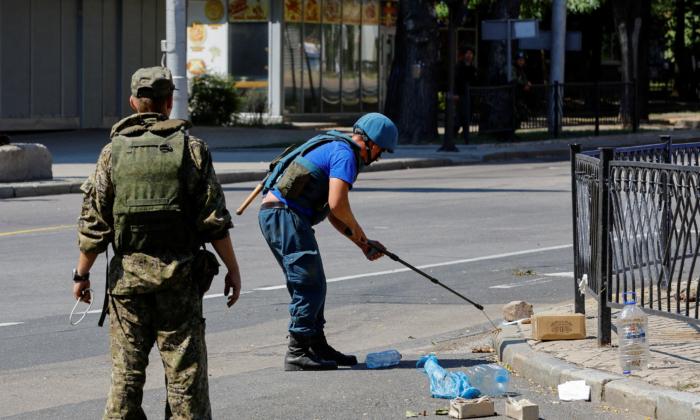Earlier this month, Finland became the fifth NATO country to announce it was abandoning the Ottawa treaty, or Anti-Personnel Mine Ban Convention (APMBC).
It comes six months after the United States agreed to supply Ukraine with anti-personnel mines.
Military analysts say the shift in policy reflects how the reality of warfare is bringing up hard truths. Still, humanitarian campaigners fear it means 30 years of progress is being unraveled.
Iain Overton, executive director of Action on Armed Violence, a United Kingdom charity, told The Epoch Times: “We’re witnessing a quiet threat to one of the most significant humanitarian disarmament successes of the last 30 years.”
Overton said the Ottawa treaty “was never just about banning a weapon, it was a global commitment to protect civilians from indiscriminate harm.”
“When nations now walk away from that pledge, they’re not only reigniting the landmine threat, they’re sending a message that civilian protection is optional in times of geopolitical tension,” he said.
“That’s a deeply troubling precedent and one that, you could argue, some within the disarmament sector haven’t done enough to prevent.”
Tim Ripley, a defense analyst and author of “Little Green Men: The Inside Story of Russia’s New Military Power,“ told The Epoch Times: ”When we weren’t fighting wars, it really didn’t make a difference. But now we’re actually in a war where they’re being used, then it’s obviously become an issue.”
They were first deployed by Gabriel J. Rains, a Confederate general, against a Union army in Virginia in 1862, killing several soldiers.
Anti-personnel mines were heavily used during World War II and the Cold War conflicts in Korea, Vietnam, and parts of Africa.
However, in the 1990s, a temporary thaw in relations between Russia and the United States made it appear the world could rid itself of these malevolent munitions.
On Sept. 18, 1997—two weeks after she died in a car crash in Paris—the APMBC was produced, and in December 1997, 122 countries—including Britain, France, Germany, and Italy—signed it.
Among the notable omissions were the United States, Russia, and China, which have never signed it.
Ripley said between 2001 and 2021, when the United States and allied forces were fighting against al-Qaeda, the Taliban, ISIS, and other Islamist forces in Iraq, Afghanistan, and elsewhere, the enemy was using improvised explosive devices (IEDs).
“All those IEDs that blew the legs off our soldiers in Afghanistan were, as near as damn it, a landmine,” he said.
“So they never actually went away, even though these treaties were signed and everybody felt Princess Diana’s pain.”
Europe’s united front against landmines has come apart since Russia invaded Ukraine in February 2022.
Meanwhile, Russia and Ukraine were both using landmines to stem the other’s advances.
“Landmines are quite an effective method of preventing your enemy maneuvering on battlefields. We saw the Russian minefields create havoc with the famous Ukrainian counter-offensive in 2023,” Ripley said.
“You had columns of Ukrainian tanks and armored vehicles that would drive forward, the first one would get blown up. The rest would get stuck behind it because they didn’t want to drive away because they’re in a minefield, and then they all got picked off by Russian anti-tank missiles and helicopters.”
Ripley said landmines had proved to be an effective “first stop mechanism” in Ukraine, which could be used to inflict “devastation” on an enemy.
Ukraine signed the APMBC in 1999, and under Article 5, it was obliged to clear all anti-personnel mines from its territory within 10 years of signing.
‘Non-Persistent’ Landmines
On Nov. 20, 2024, the United States reversed its policy on landmines and announced a new arms package for Ukraine, worth $275 million, which would include “non-persistent” anti-personnel landmines.These are designed to become inert after a preset period.
Ripley said non-persistent mines could also come with a remote switch, allowing a whole minefield to be switched on or off.
“So you can say we’re going to switch off the landmines to allow our troops to advance over them, and then switch them back on again when we want to stop the enemy,” he explained.
NATO members who have borders with Russia, or its ally Belarus, have been among the keenest to push up defense spending.
By leaving the agreement, Finland, which has the longest border with Russia of any NATO nation, could start stockpiling landmines again, in readiness for a possible invasion by Moscow.
“Finland remains committed to the humanitarian objectives of the Ottawa Convention.”
Ripley said he doubted the Finns, the Poles, or the Baltic states would immediately begin laying landmines.
Ukraine War: A Dilemma
As recently as April 2017, Princess Diana’s son, Prince Harry, stood up in front of a banner proclaiming “Landmine Free 2025” and urged people to help him, “finish the job and rid the planet of landmines.”“It is an inherent reality, and deep within its nature, that war is a cruel struggle in which one side will prevail over the other through the application of violence unless the assailed can resist the assailant,” he wrote.
Cowan, a former British Army officer, went on to say: “The deployment of landmines is a grim necessity.” He then argued for a “parallel commitment” to remove them after the conflict.
Overton told The Epoch Times: “It was disappointing not only that HALO’s CEO felt compelled to make such a public defense of anti-personnel landmines—a stance so clearly at odds with decades of humanitarian consensus—but also that so few in the disarmament world criticized him for it.”
“That silence was as telling as the statement itself. Ideals die by compromises. They die faster by compromises fuelled by the hope for government contracts that ... may never even appear,” he added.

It often takes decades to remove landmines from conflict zones.
Ripley said landmines are a “toxic legacy” of wars.
“When the war’s over, they remain and keep injuring people for years and decades afterwards, as they wander around these battlefields and accidentally stand on landmines that were laid 10, 20 years ago.”
He said the invention of anti-persistent, or “smart landmines,” which have a built-in date when they stop working and become “an inert piece of metal,” could mean preventing harm after the conflict.
The HALO Trust declined The Epoch Times’ request for comment.
The Epoch Times also asked the Department of Defense to clarify the U.S. government’s position on landmines, and the Pentagon said it had no comment.







